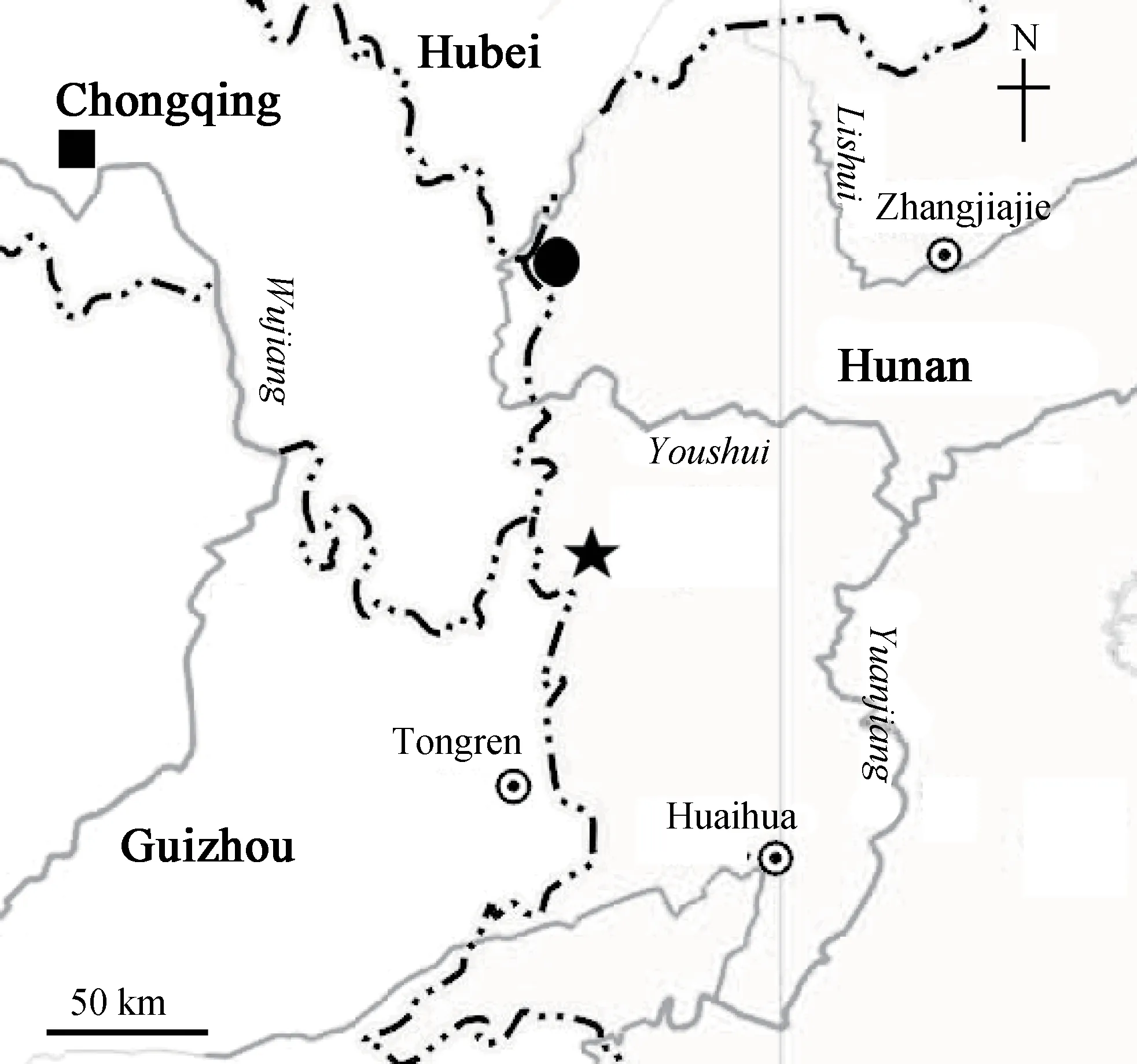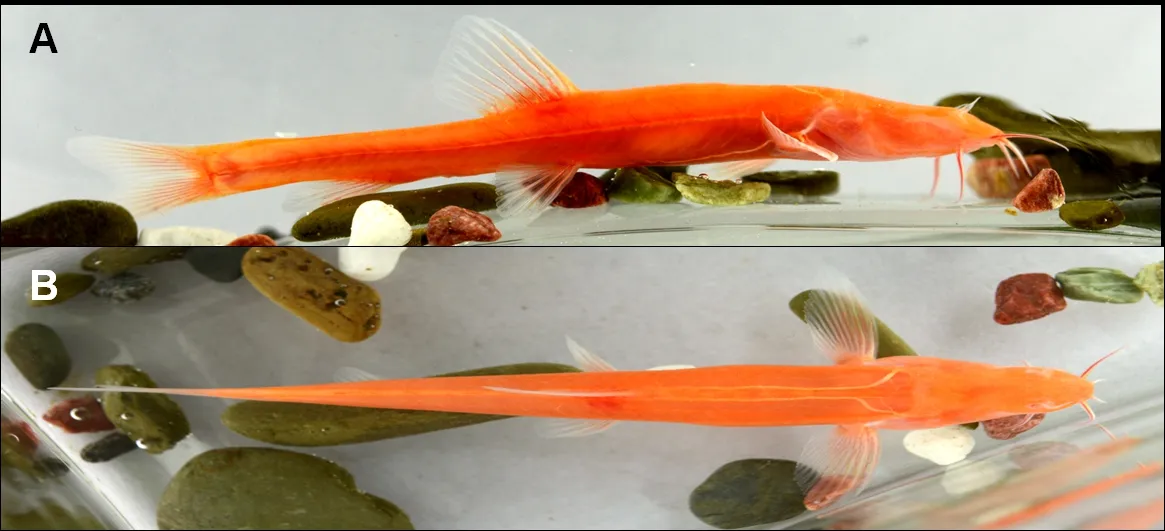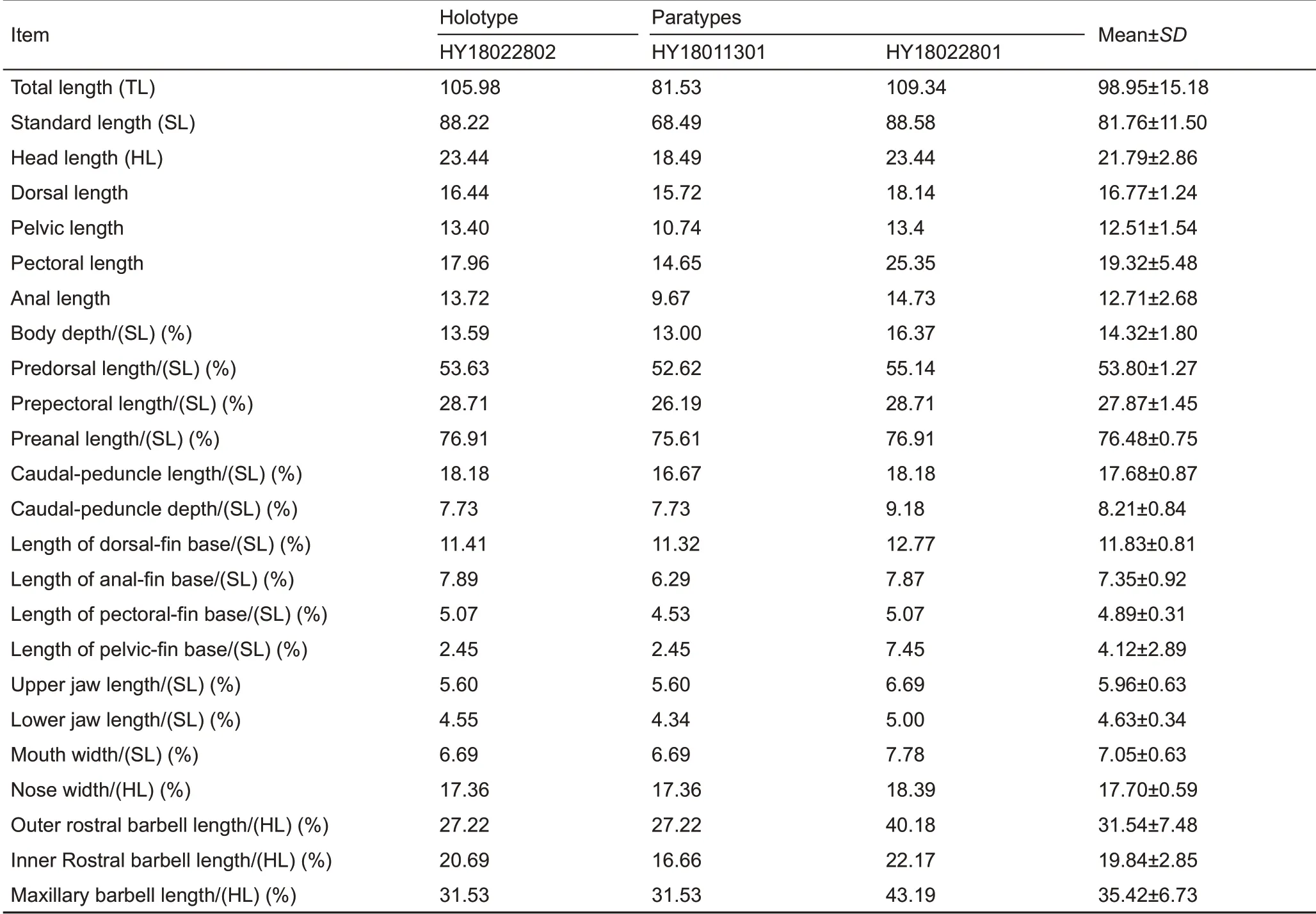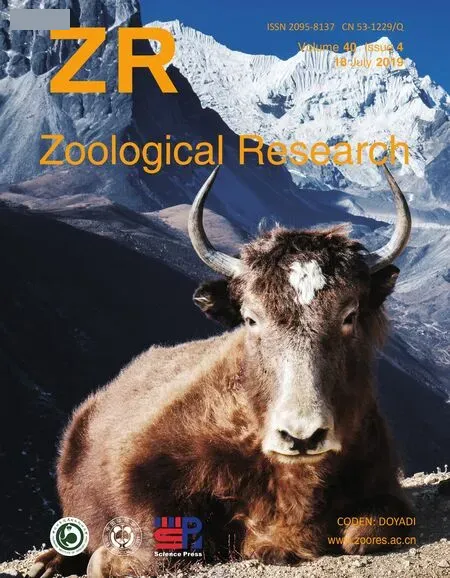A new cave-dwelling blind loach,Тriplophysa erythraea sp.nov.(cypriniformes:Nemacheilidae),from Hunan Province,china
DEAR EDITOR,A new blind loach species, Тriplophysa erythraea sp. nov.,from a karst cave in Hunan Province, central south china, is described based on morphology and cyt b gene sequencing. It can be distinguished from other species of Тriplophysa by the following combination of characters: eyes absent; body scaleless and colorless; caudal-fin 17; maxillary barbel longest; fins transparent, compressed pectoral-fin reaching 2/3 distance between pectoral-fin and pelvic-fin origins; pelvicfin and dorsal-fin origins relative; posterior chamber of airbladder well developed,long,oval,and dissociative.
Blindfish possess distinctly degenerated or completely lost eyes due to their cave or subterranean water system or deep ocean habitats (Zhao & Zhang, 2009). These specialized fish species are found within cypriniformes, mostly belonging to Sinocyclocheilus or Тriplophysa, and inhabit various inland river systems in china (Zhang & Dai, 2010). The genus Тriplophysa (Nemacheilidae, cypriniformes) is comprised of small fish living in streams and primarily distributed in the Tibetan Plateau and adjacent areas (He et al., 2011;Jacobsen et al., 2017; Xiao & Dai, 2011). A total of 202 species have been reported within the genus (Eschmeyer et al., 2018), including a number of cave-dwelling species (or populations) specialized for living in underground environments (Lan et al., 2013; Li et al., 2008; Yan, 2017). So far, a total of 30 cave-dwelling species of Тriplophysa are known to occur in china(Li et al.,2017,2018;Wu et al.,2018;Yan, 2017), of which 27 species have been identified from Yunnan, Guizhou, and Guangxi, and two from chongqing (Т.rosa) and Hunan (Т. xiangxiensis) (Lan et al., 2013; Li et al.,2017; Wu et al., 2018; Yan, 2017; Zhang & Zhao, 2016;Figure 1).
In this paper, we describe a new species of cave-dwelling Тriplophysa found during our exploration of cave animals in the Xiangxi Tujia and Miao Nationality Autonomous Prefecture,Hunan Province,central south china.
Specimens were collected in Dalong cave (N28°16'25.11'',E109° 28'57.18'', 563 m a. s. l.), Huayuan county, Hunan Province, central southern china. Morphometric measurements were made on fresh specimens with a digital caliper (0.01 mm) and a stereomicroscope (XTL-165VT) in accordance with the protocols described in the literature(Kottelat, 1984; Zhu, 1989).An abdominal muscle sample was removed and placed in ethanol (70%) for genome DNA extraction. The specimens were then preserved in formalin(10%) and deposited in the Zoological collection Room,college of Biology and Environmental Sciences, Jishou University.
DNA extraction and mitochondrial cytochrome b (cyt b)gene sequencing were carried out as described previously(Yan, 2017). Samples were sequenced by Sangon Biotech(Shanghai, china) using the Sanger method on an ABI 3707(ABI, USA) instrument. The sequencing results were uploaded to GenBank after the Blast program was run in the NcBI database for confirmation, and the cyt b sequences of several approximate species were downloaded for molecular analysis.Genetic distances were calculated by Mega 7.0 (Kumar et al.,2016) based on the Kimura 2-parameter (K2p) model (Kimura,1980).
Taxonomy
Тriplophysa erythraea sp.nov.Liu&Huang
Figures 2,3;Table 1.
Etymology:The specific name“erythraea”is derived from the blood-red body color of the living fish.Although their body surface is colorless and transparent, the red blood vessels are visible.
Holotype:HY18022802, intact, undissected, 105.98 mm TL(total length), 88.22 mm SL (standard length); Dalong cave,Huayuan county, Hunan, central southern china, 28 February 2018;coordinates N28°16'25.11'',E109°28'57.18'',563 m a.s.l..
Paratypes:HY18011301, dissected, 81.53 mm TL, 68.49 mm SL, 13 January 2018; HY18022801, dissected, 109.34 mm TL, 88.58 mm SL, 28 February 2018; two specimens collected with holotype.

Figure 1 Distribution of Triplophysa erythraea sp. nov. (★), T.xiangxiensis(●),and T.rosa(■)

Figure 2 Morphology of Triplophysa erythraea sp.nov.
Diagnosis:Тriplophysa erythraea sp. nov. can be distinguished from all species of Тriplophysa by the following combination of characters: eyes absent; body scaleless and colorless; pectoral-fin ii-10, dorsal-fin ii-8, pelvic-fin ii-5, analfin i-6, caudal-fin 17; maxillary barbel longest; fins transparent,compressed pectoral-fin reaching 2/3 of distance between pectoral-fin and pelvic-fin origin; pelvic-fin and dorsal-fin origin relative; edge of compressed pelvic-fin reaching anus; caudalfin forked; posterior chamber of airbladder well developed,long,oval,and dissociative.
Description: External characteristics:Morphometric data of the new species specimens are given in Table 1. Dorsal-fin ii-8, anal-fin i-6, pectoral-fin ii-10, pelvic-fin ii-5, caudal-fin 17, 11 gill rakers in inner row on first gill arch. cephalic lateral-line canals with 4 supratemporal, 7-9 supraorbital, 2+9-11 infraorbital, and 12 preoperculo-mandibular pores. Lateral line complete,with 63-67 pores.
Body elongated, scaleless, body side compressed posteriorly; abdominal organs and vessels of barbel, fins, and body side visible. Eyes absent. Ventral view of head fusiform,dorsum of head slightly concave in middle, posterior trunk becoming gradually smaller; trailing edge of gill covers widest and highest point of body. Snout dull, mouth inferior, upper and lower jaw arched. Edge of jaws leathery, upper jaw more developed, dentate process in center of maxilla. Lips developed, smooth, papillary process absent, lower lip with Vtype median notch.
Naris circular, slanting down; anterior and posterior naris close, diameter of posterior naris larger; anterior naris in elongated nose flap without barbel-like tip, nose flap developed as triangular petal. Three pairs of developed barbels; one pair of inner rostral barbels, outer rostral barbel,and maxillary barbel, respectively; maxillary barbel longest,outer rostral barbel longer than inner rostral barbel.
Fins transparent, pterygiophore clearly visible. Pectoral-fin compressed reaching 2/3 of distance between pectoral-fin and pelvic-fin origin, first branched ray not extended; dorsal-fin distally truncate, dorsal-fin compressed slightly longer than pelvic-fin. Distance from dorsal-fin origin to caudal-fin origin closer than to snout. Pelvic-fin origin and dorsal-fin origin equal, edge of pelvic-fin reaching anus. Distance from pelvicfin origin to anal-fin origin and caudal-fin origin to anal-fin origin equidistant. caudal-fin forked, lobe tip; anus close to anal-fin origin.
Internal structure:Four pairs of gill arches, gill filaments intensive.Anterior chamber of airbladder wrapped in dumbbellshaped bony capsule; posterior chamber expanded,dissociative, long, and oval. Stomach enlarged and U-shaped.Back of intestine bent in Z-shape. Length of intestine shorter than body length, indicating that new species is a possible demersal carnivorous fish.
Coloration:Live adults of the new species are bright red in color (Figure 3A, B), which is related to their visible blood vessels, not by skin pigmentation. Larvae are reddish white.Adults fixed in 10%formalin are pale(Figure 2A).
Sexual dimorphism:No sexual dimorphism was observed in the specimens examined.

Figure 3 Live specimens of Triplophysa erythraea sp.nov.

Table 1 Morphometric data of Triplophysa erythraea sp.nov.(all in mm)
Distribution and habitat:The new species is known only from Dalong cave, Huayuan county, Hunan Province, china(Figure 1). At the cave entrance is a hydroelectric hub, from which rushes out a fast-flowing underground river (Figure 4).The new species was found 200-450 m into the cave tunnel from the entrance, with a mean water temperature and pH of 13.5 °c and 6.0, respectively.A total of 14 blind fish (including 12 adults and two larvae) were found in the resting shallow waters during our two surveys. We did not reach the end of the cave during the surveys due to the presence of an underground river. Additional research would be beneficial to understand the eco-biological characteristics of this new species in threatened conditions.
Molecular analysis:The length of the cyt b gene sequence was 1 140 bp (GenBank accession No.: MG967615), and the average content of the A, T, c, and G bases was 28.2%,28.2%, 28.2%, and 15.4%, respectively. NcBI Blast analysis showed that the new species had highest similarity (90%) to Т.lewangensis, although their genetic distances was 11.9%,(Table 2), which surpassed the interspecies-averaged genetic distance (11.5%) of cave-dwelling Тriplophysa based on the cyt b gene(Yan,2017).

Figure 4 Habitat of Triplophysa erythraea sp.nov.

Table 2 K2p genetic distances based on the cyt b gene between Triplophysa erythraea sp. nov. and approximate species of Triplophysa
Although eyeless, with a scaleless and colorless body, the new species displayed a highly developed lateral line and barbel, indicating that it was a typical cavefish (Zhang & Dai,2010; Zhao & Zhang 2006). Furthermore, it was easily distinguished from other species in the genus Тriplophysa due to differences in eye normality or degeneration into a small black dot. Eyeless species in Тriplophysa include Т. gejiuensis(chu & chen, 1979), Т. xiangxiensis (Yang et al., 1986), Т.shilinensis (chen et al., 1992), Т. longibarbatus (chen et al.,1998), Т. qiubeiensis (Li et al., 2008), Т. huanjiangensis (Yang et al., 2011), Т. jiarongensis (Lin et al., 2012), Т. lihuensis (Wu et al., 2012), Т. fengshanensis (Lan et al., 2013), Т.dongganensis (Lan et al., 2013), and Т. anshuiensis (Wu et al.,2018).
The new species can be distinguished from Т. xiangxiensis,
Т. longibarbatus, and Т. jiarongensis by the following characters: compressed pectoral-fin reaching 2/3 of distance between pectoral-fin and pelvic-fin origin (vs. compressed pectoral-fin reaching or exceeding origin of pelvic-fin). It can be distinguished from Т. lihuensis, Т. fengshanensis, and Т.dongganensis by the following characters: maxillary barbel longest, caudal-fin forked (vs. outer rostral barbel longest,caudal-fin shallow). The new species can be distinguished from Т. gejiuensis by the following characters: distance from dorsal-fin origin to caudal-fin origin closer than to snout;maxillary barbel longest (vs. distance from dorsal-fin origin to snout closer than to caudal-fin origin; outer rostral barbel longest). It can be distinguished from Т. shilinensis by the following characters: head tapered, front of dorsal-fin slightly compressed; posterior chamber of airbladder well developed;caudal-fin 17 (vs. head long and pointed, front of dorsal-fin slightly cylindrical; posterior chamber of airbladder degenerated; caudal-fin 14). It can be distinguished from Т.huanjiangensis by the following characters: lip smooth,papillary process absent; pelvic-fin origin relative to vertical line of dorsal-fin origin; lateral line complete (lip papillary process present; pelvic-fin origin anterior to vertical line of dorsal-fin origin; lateral line absent). It can be distinguished from Т. qiubeiensis by the following characters: lip developed,smooth, papillary process absent; dentate process in center of maxilla; dorsal-fin distally truncate; posterior chamber of airbladder well developed (vs. lip developed, smooth, papillary process present; no dentate process in center of maxilla;dorsal-fin distally truncate; posterior chamber of airbladder degenerated). It can be distinguished from Т. anshuiensis by the following characters: maxillary barbel longest; pigments absent (vs. inner rostral barbel longest; black pigments irregularly present on dorsum of body).
The genetic distances indicated that the new species was most closely related to Т. lewangensis, although the values surpassed the interspecies-averaged genetic distances (Yan,2017) and Т. lewangensis possess eyes (Liang & Zhou,2019). In conclusion, based on morphology and cyt b gene sequencing, the blind loach collected from Dalong cave (N28°16'25.11'', E109° 28'57.18''), Hunan Province, central south china, was designated as a new species: Тriplophysa erythraea sp.nov.
In particular, the live adult coloration (bright-red) of the new species was different from that of other cave-dwelling Тriplophysa species (whitish, pink, or gill cover red). The collected individuals of the new species were fed for one month in our laboratory and did not change body color during that time. This suggests that the new species should be formally designated as albino; however, further research is required to determine whether the pigment regulator genes were lost.
COMPETING INTERESTS
The authors declare that they have no competing interests.
AUTHORS’CONTRIBUTIONS
Z.X.L. designed the study. Q.Z.P., X.L.H., and P.L.Z. sequenced the mitochondrial DNA. T.W. and X.Y.G. contributed to the field work. Y.X.Z.took the specimen pictures. T.F.H. and P.L.Z. wrote the manuscript with assistance from Z.X.L. and X.L.H. All authors read and approved the final version of the manuscript.
NOMENCLATURAL ACTS REGISTRATION
The electronic version of this article in portable document format will represent a published work according to the International commission on Zoological Nomenclature (IcZN), and hence the new names contained in the electronic version are effectively published under that code from the electronic edition alone (see Articles 8.5-8.6 of the code). This published work and the nomenclatural acts it contains have been registered in ZooBank, the online registration system for the IcZN. The ZooBank LSIDs(Life Science Identifiers) can be resolved and the associated information can be viewed through any standard web browser by appending the LSID to the prefixhttp://zoobank.org/.
Publication LSID:
urn:lsid:zoobank.org:pub:1F4D3cF7-3676-4EDc-B4F9-75F10FEA8F90.
Nomenclatural act LSID:
urn:lsid:zoobank.org:act:8D92F37F-DB60-4395-95F1-09F0410ABAB1.
ACKNOWLEDGEMENTS
We are grateful to Dr. Zhi-Wei LIU (Eastern Illinois University) and Dr.William Harvey Reissig (cornell University) for proofreading this manuscript, Dr. Hua-Mei Wen (Guizhou Normal University), Dr. Hai-Tao Zhao (Guizhou University of Engineering), and Dr. Zhuo-Gang Peng(Southwest University) for helping in specimen identification and offering related literature, Mr. Zhe-Yu chen (Wuhan Polytechnic University) for advice on nomenclature, and Lu-Lu Zhou, Qiang Hu, and He-Xiang Wang(Jishou University)for assisting in the DNA experiments and field work.
Tai-Fu Huang1,#,Pei-Ling Zhang1,#,Xing-Long Huang1,Tao Wu1,Xiao-Yan Gong1,You-Xiang Zhang1,Qing-Zhong Peng1,Zhi-Xiao Liu1,*1College of Biology and Environmental Sciences,Jishou University,Jishou Hunan 416000,China
#Authors contributed equally to this work
*corresponding author,E-mail:zxliu1965@163.com
- Zoological Research的其它文章
- An“impact”in publishing
- On the road to Mandalay:contribution to the Microhyla Tschudi,1838(Amphibia:Anura:Microhylidae)fauna of Myanmar with description of two new species
- Natural history of Valentin’s rock lizard(Darevskia valentini)in Armenia
- Allele-specific expression and alternative splicing in horse×donkey and cattle×yak hybrids
- Effect of temperature on antioxidant defense and innate immunity in Brandt’s voles
- Leukocyte cell-derived chemotaxin 2 inhibits development of atherosclerosis in mice

